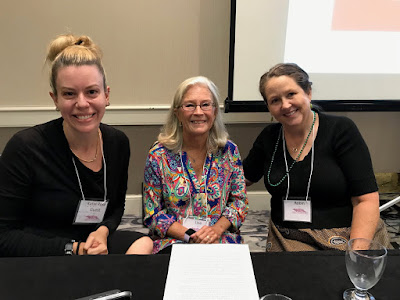On a spur of the moment I decided to attend a panel discussion with Lisa Kline, Robin Kirk, and Katie Pryle; I was glad that I did! Lisa and Robin are both authors who have been published by Blue Crow Publishing, a traditional small press which Katie co-founded with Lauren Faulkenberry.
 |
| Katie Pryal, Lisa Kline, Robin Kirk |
LISA KLINE
My blog readers are no strangers to Lisa's work. I was privileged to host her cover reveal of her most recent book, One Week of You, wrote about Summer of the Wolves, and blogged about her first book, Eleanor Hill.
Lisa has published ten books with publishers of varying sizes including Carus Publishing, Delacorte Press, Zondervan, and now Blue Crow. Her books have been both agented and non-agented. She submitted to Blue Crow without an agent and was impressed with their prompt response; an offer of publication followed within weeks of her requested revisions. This was very different than the long wait she had sometimes experienced with the larger publishing houses.
Lisa said she has enjoyed her personal connection with Katie and Lauren. "Publishers who are writers know what it’s like to write and publish a book. Katie and Lauren’s comments inspired me to make my book better.”
Lisa acknowledged that when your book is with a smaller publisher it may be more challenging to get reviews. Although all the publishers have given her marketing assistance and submitted her books for awards, the downside of a large publisher is that after six months the publisher sometimes must turn to the next book they need to promote.
Blue Crow continues to promote One Week of You on their site and at conferences. In addition, they promote whatever she does. Lisa finds that she has to do a good deal of her own marketing, but all authors in today’s publishing atmosphere must market. Lisa received a larger royalty than most publishers offer, but not an advance.
ROBIN KIRK
Robin Kirk's debut novel The Bond, is a young adult post-apocalyptic story that is much different than the nonfiction titles she has previously published.
In her presentation, Robin recommended researching all publishing options. Her nonfiction books have been published by Duke University Press, The University of Massachusetts Press, and others. She suggested I consider contacting the Charlotte Historical Society as a potential publisher for HALF-TRUTHS.
She discussed the pros and cons of hybrid publishing which often demands a large investment of time and money. Robin recommended reading what Lyn Miller-Lachmann had to say on the topic if you are interested in pursuing it. Forming a co-op with other authors who publish similar books is another option. Here is an article by Jane Friedman on that. Authors can create a website, form imprints, share resources and even purchase ISBN numbers this way. Here is a link to Jane Friedman's popular chart on different publishing paths.
Robin also recommended joining the Authors Guild as well as a Facebook group in your writing genre. Finally, she also recommended Zotero, which is a free online bibliography manager that is awesome. Thanks to Robin, my next WIP already has a budding bibliography!
KATIE PRYAL
Katie Rose Guest Pryal is the co-publisher of Blue Crow Publishing. Here were some of her observations:
- She has yet to hear positive experience about hybrid publishing by which she means publishers that require you to pay to get your book published while also requiring you to surrender your rights. On the other hand, she strongly supports self-publishing and author co-op groups.
- Traditional publishing thrives on keeping authors in the dark. She and Lauren founded Blue Crow with the intention of being transparent, honest, and available to their authors. (Check out their mission statement.)
- Blue Crow receives unagented submissions and publishes about five books a year.
- Referral via one of their authors is the best way to connect with her.
- The landscape of trade reviews is changing. It is hard for small presses to get picked up by the trades. At the same time, however, book bloggers are becoming more and more important, even more important than trade reviews, when it comes to marketing a book to a wide audience.
That final note was music to my ears! It reminded me of my experience at Highlights Summer Camp in 2016 when assistant editor, Cherie Matthews, announced that Carol Baldwin's blog was one that she followed--without knowing I was in the audience! Both times I felt validated--all my blogging work is paying off!
Speaking of small with big dreams, I think my friend's son was the smallest attendee at the fall conference. He has been "reading" for months!




















